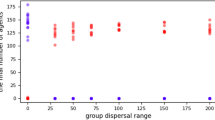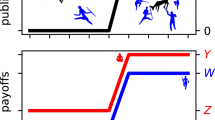Abstract
To explain the evolution of cooperation by natural selection has been a major goal of biologists since Darwin. Cooperators help others at a cost to themselves, while defectors receive the benefits of altruism without providing any help in return. The standard game dynamical formulation is the ‘Prisoner's Dilemma’1,2,3,4,5,6,7,8,9,10,11, in which two players have a choice between cooperation and defection. In the repeated game, cooperators using direct reciprocity cannot be exploited by defectors, but it is unclear how such cooperators can arise in the first place12,13,14,15. In general, defectors are stable against invasion by cooperators. This understanding is based on traditional concepts of evolutionary stability and dynamics in infinite populations16,17,18,19,20. Here we study evolutionary game dynamics in finite populations21,22,23,24,25. We show that a single cooperator using a strategy like ‘tit-for-tat’ can invade a population of defectors with a probability that corresponds to a net selective advantage. We specify the conditions required for natural selection to favour the emergence of cooperation and define evolutionary stability in finite populations.
This is a preview of subscription content, access via your institution
Access options
Subscribe to this journal
Receive 51 print issues and online access
$199.00 per year
only $3.90 per issue
Buy this article
- Purchase on Springer Link
- Instant access to full article PDF
Prices may be subject to local taxes which are calculated during checkout



Similar content being viewed by others
References
Trivers, R. The evolution of reciprocal altruism. Q. Rev. Biol. 46, 35–57 (1971)
Axelrod, R. & Hamilton, W. D. The evolution of cooperation. Science 211, 1390–1396 (1981)
Axelrod, R. The Evolution of Cooperation (Basic Books, New York, 1984)
Milinski, M. Tit for tat in sticklebacks and the evolution of cooperation. Nature 325, 433–435 (1987)
May, R. M. More evolution of cooperation. Nature 327, 15–17 (1987)
Dugatkin, L. A. Cooperation Among Animals (Oxford Univ. Press, Oxford, UK, 1997)
Pfeiffer, T., Schuster, S. & Bonhoeffer, S. Cooperation and competition in the evolution of ATP-producing pathways. Science 292, 504–507 (2001)
Fehr, E. & Fischbacher, U. The nature of human altruism. Nature 425, 785–791 (2003)
Hammerstein, P. (ed.) Genetic and Cultural Evolution of Cooperation (MIT Press, Cambridge, Massachusetts, 2003)
Boyd, R., Gintis, H., Bowels, S. & Richerson, P. J. The evolution of altruistic punishment. Proc. Natl Acad. Sci. USA 100, 3531–3535 (2003)
Fudenberg, D. & Maskin, E. Evolution and cooperation in noisy repeated games. Am. Econ. Rev. 80, 274–279 (1990)
Nowak, M. A. & Sigmund, K. Tit for tat in heterogeneous populations. Nature 355, 250–253 (1992)
Nowak, M. A. & May, R. M. Evolutionary games and spatial chaos. Nature 359, 826–829 (1992)
Killingback, T. & Doebeli, M. Self-organized criticality in spatial evolutionary game theory. J. Theor. Biol. 191, 335–340 (1998)
Fudenberg, D. & Harris, C. Evolutionary dynamics with aggregate shocks. J. Econ. Theor. 57, 420–441 (1992)
Maynard Smith, J. & Price, G. R. Logic of animal conflict. Nature 246, 15–18 (1973)
Taylor, P. D. & Jonker, L. B. Evolutionary stable strategies and game dynamics. Math. Biosci. 40, 145–156 (1978)
Maynard Smith, J. Evolution and the Theory of Games (Cambridge Univ. Press, Cambridge, UK, 1982)
Hofbauer, J. & Sigmund, K. Evolutionary Games and Population Dynamics (Cambridge Univ. Press, Cambridge, UK, 1998)
Hofbauer, J. & Sigmund, K. Evolutionary game dynamics. Bull. Am. Math. Soc. 40, 479–519 (2003)
Riley, J. G. Evolutionary equilibrium strategies. J. Theor. Biol. 76, 109–123 (1979)
Schaffer, M. Evolutionary stable strategies for a finite population and a variable contest size. J. Theor. Biol. 132, 469–478 (1988)
Fogel, G., Andrews, P. & Fogel, D. On the instability of evolutionary stable strategies in small populations. Ecol. Model. 109, 283–294 (1998)
Ficci, S. & Pollack, J. Effects of Finite Populations on Evolutionary Stable Strategies. Proc. 2000 Genetic and Evolutionary Computation Conf. (ed. Whitley, D.) 927–934 (Morgan-Kaufmann, San Francisco, 2000)
Schreiber, S. Urn models, replicator processes, and random genetic drift. Siam. J. Appl. Math. 61, 2148–2167 (2001)
Moran, P. A. P. The Statistical Processes of Evolutionary Theory (Clarendon, Oxford, UK, 1962)
Karlin, S. & Taylor, H. M. A First Course in Stochastic Processes 2nd edn (Academic, London, 1975)
Kimura, M. Evolutionary rate at the molecular level. Nature 217, 624–626 (1968)
Hamilton, W. D. Extraordinary sex ratios. Science 156, 477–488 (1967)
Nowak, M. A. & Sigmund, K. A strategy of win-stay, lose-shift that outperforms tit for tat in Prisoner's Dilemma. Nature 364, 56–58 (1993)
Binmore, K. & Samuelson, L. Evolutionary stability in repeated games played by the finite automata. J. Econ. Theor. 57, 278–305 (1992)
Acknowledgements
The Program for Evolutionary Dynamics is supported by J. Epstein.
Author information
Authors and Affiliations
Corresponding author
Ethics declarations
Competing interests
The authors declare that they have no competing financial interests.
Rights and permissions
About this article
Cite this article
Nowak, M., Sasaki, A., Taylor, C. et al. Emergence of cooperation and evolutionary stability in finite populations. Nature 428, 646–650 (2004). https://doi.org/10.1038/nature02414
Received:
Accepted:
Issue Date:
DOI: https://doi.org/10.1038/nature02414
This article is cited by
-
Effect of reciprocity mechanisms on evolutionary dynamics in feedback-evolving games
Nonlinear Dynamics (2024)
-
Strategy evolution on dynamic networks
Nature Computational Science (2023)
-
The effect of environmental information on evolution of cooperation in stochastic games
Nature Communications (2023)
-
Intrinsic fluctuations of reinforcement learning promote cooperation
Scientific Reports (2023)
-
Imitation dynamics on networks with incomplete information
Nature Communications (2023)
Comments
By submitting a comment you agree to abide by our Terms and Community Guidelines. If you find something abusive or that does not comply with our terms or guidelines please flag it as inappropriate.



